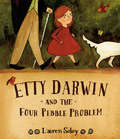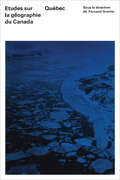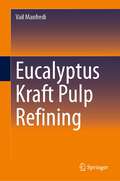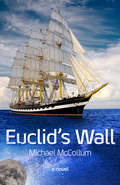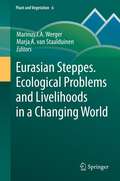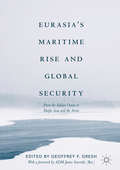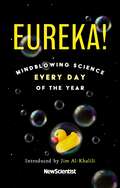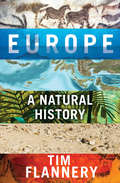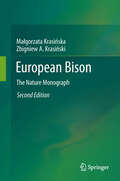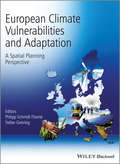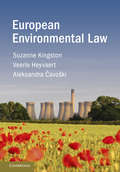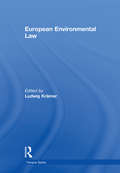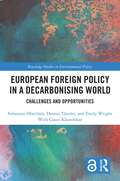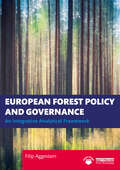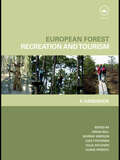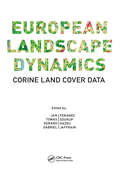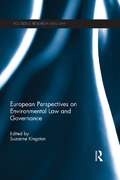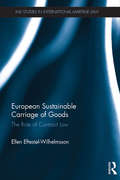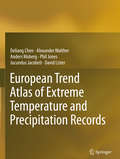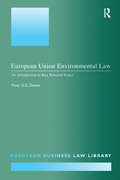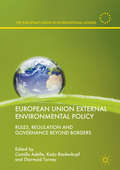- Table View
- List View
Ethylene in Plants
by Chi-Kuang WenThis book focuses on recent advances in our understanding of the signal transduction pathway of ethylene, its interaction with other hormones and its roles in biological processes. It discusses at which point plants could have acquired ethylene signaling from an evolutionary perspective. Ethylene was the first gaseous hormone to be identified and triggers various responses in higher plants. Our grasp of ethylene signaling has rapidly expanded over the past two decades, due in part to the isolation of the components involved in the signal transduction pathway. The book offers a helpful guide for plant scientists and graduate students in related areas.
Etty Darwin and the Four Pebble Problem
by Lauren SoloyEtty Darwin and her famous father go for a walk to ponder life, science . . . and fairies! Inspired by the real-life daughter of Charles Darwin.Etty loves make-believe.Her dad loves science.Etty believes in fairies.Her dad would need to see some proof that they exist. But they both love nature, conversation and each other. A gorgeous rumination on belief and imagination featuring Henrietta (Etty) Darwin and her famous father, Charles. Etty went on to become a valued and keen editor of Charles's work and a thoughtful and intellectual being in her own right. This imagined conversation between Etty and Charles as they stroll around Charles's real-life "thinking track" explores their close relationship and shows that even science is nothing without an open mind and imagination.
Etudes sur la Geographie du Canada
by Fernand GrenierThe publication of the series, 'Studies in Canadian Geography,' by the organizers of the 22nd International Geographical Congress, introduces to the international community of geographers a new perspective of the regional entities which form this vast countries. These studies should contribute to a better understanding among scholars, students, and the people of Canada of the geography of their land. Geographical works embracing the whole of Canada, few in number until recently, have become more numerous during the last few years. This series is original in its purpose of re-evaluating the regional geography of Canada. In the hope of discovering the dynamic trends and the processes responsible for them, the editors and authors of these volumes have sought to interpret the main characteristics and unique attributes of the various regions, rather than follow a strictly inventorial approach. In preparing this volume on Quebec, the contributors have looked at the evolution and present patterns of the ecumene of southern Québec, rural and urban Québec, and the dynamic biogeography of Québec.
Eucalyptus Kraft Pulp Refining
by Vail ManfrediThis book presents a brief history of papermaking followed by comments regarding wood as a source of fibers, including its chemical and anatomical characteristics and the influence of these aspects on the quality of the pulp produced. In addition, the author describes the effects of the pulping process, mainly a chemical process, on pulp quality and how these wood characteristics influence both the refining process as the quality of the final paper. The book further provides a broad discussion, based on experimental results, on the contribution of the main operating refining variables and the main strategies that can be used industrially to optimize the operating results. From this evaluation, the parameter that complements the specific edge load theory is identified. This parameter is related to the retention time of the fiber flocs inside the refiner.
Euclid’s Wall
by Michael McCollumA century after civilization fell in a day and a night of tectonic cataclysm, scattered communities have regained a fraction of what humanity lost on that Day of Destruction. One such is the Duchy of Hampshire on the southern tip of England.Hampshire is at war with the Califat de Normandie. It is a war that has been profitable for merchant sea captain Ethan Scott of the Sailing Barque Hellespont. Despite the money to be made, Scott prays for the war to end. Each time he puts to sea, he risks his ship and the lives of his crew on his ability to evade the Norman raiders in the Channel and the Eirish Sea. It is a gamble he will inevitably lose if he keeps at it too long.The Duke of Hampshire has problems of his own. War is expensive. If he doesn’t find additional resources soon, he will be defeated. The Duke plans to send an expedition to North America to discover whether the fabled wealth of old still exists there. For that, he needs a ship.Scott’s chance meeting with a beautiful woman presents both men with the solution to their respective problems. Soon Hellespont sets sail for America and the mysterious Wall that scholars believe precipitated the fall of civilization, and which may yet destroy the world.
Eurasian Steppes. Ecological Problems and Livelihoods in a Changing World
by Marinus J.A. Werger Marja A. van StaalduinenSteppes form one of the largest biomes. Drastic changes in steppe ecology, land use and livelihoods came with the emergence, and again with the collapse, of communist states. Excessive ploughing and vast influx of people into the steppe zone led to a strong decline in nomadic pastoralism in the Soviet Union and China and in severely degraded steppe ecosystems. In Mongolia nomadic pastoralism persisted, but steppes degraded because of strongly increased livestock loads. After the Soviet collapse steppes regenerated on huge tracts of fallow land. Presently, new, restorative steppe land management schemes are applied. On top of all these changes come strong effects of climate change in the northern part of the steppe zone. This book gives an up-to-date overview of changes in ecology, climate and use of the entire Eurasian steppe area and their effects on livelihoods of steppe people. It integrates knowledge that so far was available only in a spectrum of locally used languages.
Eurasia’s Maritime Rise and Global Security: From The Indian Ocean To Pacific Asia And The Arctic (Palgrave Studies in Maritime Politics and Security)
by Geoffrey F. GreshThis book explores Eurasia’s growing embrace of its maritime geography from the Indian Ocean to Pacific Asia and the Arctic. In an age of climate change, the melting of the Arctic will transform Eurasia’s importance, in addition to influencing the political, economic, and military dynamics across Eurasia’s main maritime regions. These emerging shifts have already begun to alter maritime trade and investment patterns, and thus the global political economy. It also creates a rising threat to the current status quo of world order that has long been dominated by the Atlantic World. This edited volume showcases some of the world’s leading experts and examines Eurasia from a saltwater perspective, analyzing its main maritime spaces in a threefold manner—as avenue, as arena, as source—to show the significance of this geostrategic change and why it matters for the future of the world’s oceans.
Eureka!: 50 Scientists Who Shaped Human History
by John GrantGalileo, Einstein, Curie, Darwin, Hawking — we know the names, but how much do we really know about these people? Galileo gained notoriety from his battle with the Vatican over the question of heliocentrism, but did you know that he was also an accomplished lute player? And Darwin of course discovered the principle by which new species are formed, but his bold curiosity extended to the dinner table as well. (And how many people can say they've eaten an owl!) In Eureka! John Grant — author of Debunk It!, Discarded Science, Spooky Science and many others — offers fifty vivid portraits of groundbreaking scientists, focusing not just on the ideas and breakthroughs that made them so important but also on their lives and their various...quirks.
Eureka!: Mindblowing Science Every Day of the Year
by New ScientistIntroduced by Jim Al-KhaliliCould you surf down an erupting volcano?Why do zebras have stripes?Are you breathing the same air as Leonardo da Vinci?Are there any green mammals?Why do pineapples have spikes?Why do songs get stuck in your head?What happens when black holes collide?Can you extract your DNA?New Scientist has been a treasure trove of fascinating and surprising questions and answers for over a decade. From how to measure the speed of light using chocolate, to why dogs howl at sirens, Eureka! brings together 365 mindblowing questions, fascinating facts and exciting experiments.If you've ever wondered how to escape quicksand, what would happen if the moon vanished, and why cats (nearly) always land on their feet, you've come to the right place.
Eureka!: Mindblowing Science Every Day of the Year
by New ScientistIntroduced by Jim Al-KhaliliCould you surf down an erupting volcano?Why do zebras have stripes?Are you breathing the same air as Leonardo da Vinci?Are there any green mammals?Why do pineapples have spikes?Why do songs get stuck in your head?What happens when black holes collide?Can you extract your DNA?New Scientist has been a treasure trove of fascinating and surprising questions and answers for over a decade. From how to measure the speed of light using chocolate, to why dogs howl at sirens, Eureka! brings together 365 mindblowing questions, fascinating facts and exciting experiments.If you've ever wondered how to escape quicksand, what would happen if the moon vanished, and why cats (nearly) always land on their feet, you've come to the right place.
Europe and the Management of Globalization (ISSN)
by Sophie Meunier Wade JacobyEuropean politicians often speak of their efforts to 'manage globalization.' At one level, this is merely a rhetorical device to make globalization more palatable to citizens and prove that policy-makers are still firmly in control of their country’s fate. This volume argues that the advocacy of managed globalization goes beyond rhetoric and actually has been a primary driver of major European Union (EU) policies in the past twenty years. The EU has indeed tried to manage globalization through the use of five major mechanisms: 1) expanding policy scope 2) exercising regulatory influence 3) empowering international institutions 4) enlarging the territorial sphere of EU influence, and 5) redistributing the costs of globalization. These mechanisms are neither entirely novel, nor are they always effective but they provide the contours of an approach to globalization that is neither ad hoc deregulation, nor old-style economic protectionism.The recent financial crisis may have seemed initially to vindicate the European efforts to manage globalization, but it also represented the limits of such efforts without the full participation of the US and China. The EU cannot rig the game of globalization, but it can try to provide predictability, oversight, and regularity with rules that accommodate European interests.This book was based on a special issue of Journal of European Public Policy.
Europe: A Natural History
by Tim FlanneryA tale of cave bears and comet strikes and a hundred million years of history by the bestselling author of Here on Earth: &“Marvelous.&”—Publishers Weekly (starred review) In Europe: A Natural History, world-renowned scientist, explorer, and conservationist Tim Flannery applies the eloquent interdisciplinary approach he used in his ecological histories of Australia and North America to the story of Europe. He begins 100 million years ago, when the continents of Asia, North America, and Africa interacted to create an island archipelago that would later become the Europe we know today. It was on these ancient tropical lands that the first distinctly European organisms evolved. Flannery teaches us about Europe&’s midwife toad, which has endured since the continent&’s beginning, while elephants, crocodiles, and giant sharks have come and gone. He explores the monumental changes wrought by the devastating comet strike and shows how rapid atmospheric shifts transformed the European archipelago into a single landmass during the Eocene. As the story moves through millions of years of evolutionary history, Flannery eventually turns to our own species, describing the immense impact humans had on the continent&’s flora and fauna—within 30,000 years of our arrival in Europe, the woolly rhino, the cave bear, and the giant elk, among others, would disappear completely. The story continues right up to the present, as Flannery describes Europe&’s leading role in wildlife restoration, and then looks ahead to ponder the continent&’s future: with advancements in gene editing technology, European scientists are working to recreate some of the continent&’s lost creatures, such as the great ox of Europe&’s primeval forests and even the woolly mammoth.
European Bison
by Małgorzata Krasińska Zbigniew A. KrasińskiThe mighty and majestic European bison is the relictual embodiment of the wildness of prehistoric Europe. Tragically, the millennia since that time have seen so many species driven to extinction by human impacts, and the European bison has only narrowly avoided the same fate. Today, the species represents the symbolic sentinel of successful conservation actions in a world in which such achievements remain few and far between. From an early stage in the restitution of the European bison, husband-and-wife team Małgorzata Krasińska and Zbigniew A. Krasiński have been participating in relevant management initiatives and researching all facets of the bison, from its morphology and diet, to its movements, social life and reproduction, and the conservation management actions that have been taken to save it. Now they have summarised this wealth of knowledge on the species, giving rise to a publication ideal for students, professional biologists and conservationists, but also for all nature enthusiasts. This new edition of the monograph offers extensively updated content taking into account research carried out on the European bison in the last few years. Also featured, a new chapter devoted to knowledge of the genetics of the species drawn up by Małgorzata Tokarska of the Białowieża-based Mammal Research Institute PAS.
European Climate Vulnerabilities and Adaptation
by Philipp Schmidt-Thome Stefan GreivingEuropean Climate Vulnerabilities and Adaptation: A Spatial Planning Perspective analyses the impacts climate change might have on regions and their local economies. Regions clearly differ in view of the complex patterns of climate change impact, but also regarding the given vulnerability and coping capacity.Impacts of climate change can have a marked effect on the functioning of regions and sectors of the society, if not properly addressed. Readiness to adapt to the impacts and lasting changes counts towards vulnerability of the regions.The book builds upon the findings of a project conducted under the European observation network for territorial development and cohesion (ESPON), The ESPON Climate project. Following the stipulations of the ESPON programme and the tender for this project the territorial focus is the raison d'être and methodological core of the project as a whole and its various research actions: The outcomes of each action will be focused on what impacts global climate change will have for the different European regions and how the regions can cope with the projected impacts in order to become less vulnerable to climate change.This book: Provides a comprehensive analysis of climate change impacts on 29 European regions and their local economiesTakes an interdisciplinary approach dealing with the physical, social, economic, environmental, cultural and institutional aspects of climate change vulnerability and the consequences for spatial planningBuilds on the findings of the ESPON Climate project with a policy focused approachIs in full colour throughout with a broad range of case studies
European Environmental Law (Routledge Research In European Union Law Ser.)
by Suzanne Kingston Veerle Heyvaert Aleksandra ČavoškiEU Environmental Law is a critical, comprehensive and engaging account of the essential and emerging issues in European environmental law and regulation today. Suitable for advanced undergraduate and postgraduate students, the book delivers a thematic and contextual treatment of the subject for those taking courses in environmental law, environmental studies, regulation and public policy, and government and international relations. Placing the key issues in context, EU Environmental Law takes an interdisciplinary and thematic approach to help students to better understand the implementation and enforcement of environmental law and policy across Europe. It offers an accessible overview, and links theory with practical applications that will allow students to contextualise the outcomes of legal rules and their impact on public and private behaviours. It provides a definitive account of the subject, examining traditional topics such as nature conservation law, waste law and water law, alongside increasingly important fields such as the law of climate change, environmental human rights law, and regulation of GMOs and nanotechnology.
European Environmental Law: A Comparative Perspective (Tempus Series)
by Ludwig KrämerEuropean Environmental Law pulls together the most significant material on the subject from legal and other periodicals to form an essential compendium for those wishing to study the role of law in protecting and conserving the environment. The studies are arranged in three sections which examine the Europeanisation of law and policy, analyse the application and enforcement of law and discuss the improvement of standards in Europe.
European Foreign Policy in a Decarbonising World: Challenges and Opportunities (Routledge Studies in Environmental Policy)
by Sebastian Oberthür Gauri Khandekar Dennis Tänzler Emily WrightContributing to the emerging literature on the geopolitical and foreign policy implications of decarbonisation and energy transition processes, this book sheds light on the future of the European Union’s external relations under decarbonisation. Under the Paris Agreement on climate change, adopted in 2015, governments committed to phasing out the emissions of carbon dioxide and other greenhouse gases over the coming decades. This book addresses the many questions around this process of decarbonisation through detailed analyses of EU external relations with six fossil-fuel exporting countries: Nigeria, Indonesia, Azerbaijan, Colombia, Qatar and Canada. The authors systematically examine the six countries’ varying dependence on fossil fuels, the broader political and security context, current relations with the EU and the potential for developing these toward decarbonisation. In doing so, they put forward a series of findings that should hold across varying circumstances and provide a steppingstone to enrich and inspire further research on foreign policy, external relations and international relations under decarbonisation. The book also makes an important contribution to understanding the external implications of the 2019 European Green Deal. This volume will be of great interest to students and scholars of European environmental and climate policy, climate diplomacy, energy policy, foreign policy and climate/energy geopolitics.
European Forest Policy and Governance: An Integrative Analytical Framework
by Filip AggestamThis book provides a state-of-the-art overview covering distinct and relevant aspects of forest policy processes in Europe, presenting a fresh perspective on different analytical approaches, theories, and frameworks.Set against the background of a changing world, driven by significant social, environmental, and economic developments, in Europe and elsewhere, there is a growing need for an improved understanding of forest governance and how to analyse the forest policymaking processes. This book introduces the reader to some of the key issues typically encountered in reviewing proposed as well as established forest policies, focusing on five socially relevant topics for the forest-based sector today, namely: European forest governance under a green new deal Systemic changes and the circular (bio-)economy Social changes connected with forest ownership and forest actors Nature conservation and the pursuit of multifunctional forests Living with forest fires and climate change. In so doing, this book presents a set of timely and rich case studies relevant to the study of forest governance. In the final chapter, it puts forward an innovative and systematic method for selecting the most appropriate analytical tool that accounts for the constraints and objectives involved in monitoring forest policy. The book is accompanied by chapter-level exercises and online Support Material which details the various approaches, theories, and frameworks discussed in the book, providing direct links back to individual chapters, discussion points, and a step-by-step guide for how each method can be applied.This book will be an essential read for forestry students and scholars, and professionals and policymakers working on forest policy and forest management.
European Forest Recreation and Tourism: A Handbook
by Simon Bell Ulrike Pröbstl Murray Simpson Liisa Tyrväinen Tuija SievänenIn an increasingly urbanized world more and more people are turning to our forests and woodland for recreation and tourism. Planning and providing for this growing demand poses challenges that need to be addressed by managers and designers alike. Based on a study of forest recreation from across Europe, the editors bring together the expertise of more than eighty leading professionals and academics to provide a clear and concise guide to best practice. Case studies and careful research give a detailed insight into the issues that forest recreation raises, from strategic planning to integration into the existing rural economy. Essential reading for tourism planners, landscape designers and countryside managers delivering forest recreation and tourism.
European Landscape Dynamics: CORINE Land Cover Data
by Jan Tomas Gerard Gabriel Feranec Soukup Hazeu JaffrainFour unique pan-European CORINE Land Cover datasets—CLC1990, CLC2000, CLC2006, and CLC2012— and three datasets concerning changes between 1990 and 2012 have presented the first-ever opportunity to observe the European landscape by means of land cover and its change. This book brings together all these datasets to demonstrate the methods of identification, analysis and assessment of the European land cover and its changes that took place during the intervals of 1990–2000, 2000–2006, and 2006–2012. It provides examples in which CLC data plays a role in offering solutions to European environmental problems such as the monitoring of urban dynamics, land fragmentation, ecosystems mapping and assessment, and high nature value farmland characteristics. Existing environmental problems require new approaches, and European Landscape Dynamics: CORINE Land Cover Data indicates a set of outlooks for CLC data generation that produce more detailed levels of analysis and bottom-up approaches while addressing the relationship of CLC data to the Infrastructure for Spatial Information in Europe (INSPIRE). It also discusses the future of CLC data generation. A valuable resource of up-to-date information, it is useful to professionals such as scientists, territorial planners, and environmentalists as well as students of geosciences and all those who are interested in cognition of the European landscape, its changes and development.
European Perspectives on Environmental Law and Governance (Routledge Research in EU Law)
by Suzanne KingstonThis book provides a range of perspectives on some of the most pressing contemporary challenges in EU environmental law and governance from some of today’s leading European environmental academics and practitioners. The book maintains a focus on three key cross-cutting issues, each of which is carefully analysed through the lens of governance. The first theme to be addressed is that of climate change and the problems it poses for EU governance. The second issue explored concerns the challenge of integrating environmental considerations into other policy areas, as is required by the Treaty on the Functioning of the European Union and the EU’s Charter of Fundamental Rights. Finally, the third theme centres on the important challenge of improving environmental enforcement within the EU, and considers issues such as the Aarhus Convention and the evolution of the Commission’s work on implementation and enforcement throughout the past twenty years. Each of these three themes is situated within the broader ongoing debate about the changing nature of European environmental governance post-Lisbon and the ways in which developments in this area fits within broader trends in European governance theory and policy generally. European Perspectives on Environmental Law and Governance contains contributions from experts in the field including; Mary Robinson, Alan Boyle, Ludwig Kramer and Liam Cashman, and will be of interest to academics, students and practitioners of EU environmental law.
European Sustainable Carriage of Goods: The Role of Contract Law (IMLI Studies in International Maritime Law)
by Ellen Eftestøl-WilhelmssonThis work discusses the rapidly developing European transport policy on sustainable freight and the connected efforts initiated by the European Commission (EC) on greening transport by the means of contract law. Greening transport has been a central goal for the EU for decades. The main problem has been, and still is, that far too much carriage of goods within the EU is performed unimodally: by road carriage alone. This has caused severe problems particularly in central Europe, where both trade and environment is suffering from an ineffective transport industry with growing problems of congestion and pollution. A modal shift in transport from mainly road based to a form of transport in which more environmental friendly modes such as rail, inland waterways and sea born transport are integrated into one transport chain, is hence an objective of the EU. If successful, this model could then be extended to the international transport community. The key question raised in this book is whether the traditional role of contract law is changing to such an extent that the parties involved must take external interests into account. In the case of the EU’s efforts to enhance sustainable carriage of goods within its realm, the author explores whether governmental interference is necessary, or if we can trust that the parties will integrate environmental issues into their contracts because there is a demand for such clauses. The different proposals for an EU regime on multimodal contracts of carriage are discussed in this context. This book will be of great relevance to academics and practitioners with an interest in EU law, transport law, environmental law and maritime law in general.
European Trend Atlas of Extreme Temperature and Precipitation Records
by Phil Jones Deliang Chen Alexander Walther Anders Moberg Jucundus Jacobeit David ListerThis Atlas presents records of climatic variability and change in Europe starting before 1901 and focuses especially on trends of extreme temperatures and precipitation. The authors have used software developed within EMULATE (European and North Atlantic daily to MULtidecadal climATE variability) to obtain the extremes indices and temporal trends. The trend atlas provides an easy way to identify spatial patterns for a given time period, region, season, and index. The Atlas clearly shows that climate in Europe has changed over the last 100 to 150 years, such that the occurrence and intensity of warm temperature extremes have increased. Precipitation extremes have also changed, but with a less clear pattern compared to the temperature extremes.
European Union Environmental Law: An Introduction to Key Selected Issues (European Business Law Library #7)
by Peter G.G. DaviesThis comprehensive book provides analysis and discussion on the following key issues in EU environmental law: environmental competence, principles and objectives, implementation and enforcement, nature protection, impact assessment, trade and the environment, waste management, climate change and the EU. An accessible work for all students of the subject both academic or professional.
European Union External Environmental Policy
by Camilla Adelle Katja Biedenkopf Diarmuid TorneyThis book considers the environmental policies that the EU employs outside its borders. Using a systematic and coherent approach to cover a range of EU activities, environmental issues, and geographical areas, it charts the EU's attempts to shape environmental governance beyond its borders. Key questions addressed include: What environmental norms, rules and policies does the EU seek to promote outside its territory? What types of activities does the EU engage in to pursue these objectives? How successful is the EU in achieving its external environmental policy objectives? What factors explain the degree to which the EU attains its goals? The book will be of interest to students and academics as well as practitioners in governments (both inside and outside of the EU), the EU institutions, think tanks, and research institutes.

